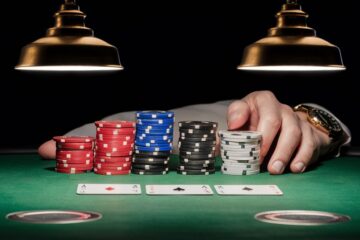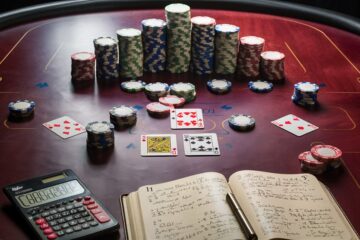How Do Near Miss Effects in Slot Machines Affect Your Brain?
Key Takeaways:
- Near misses trigger dopamine release similar to actual wins
- Slot machines deliberately program near miss events to encourage continued play
- Understanding these psychological mechanisms helps players make informed decisions
The Science Behind Near Miss Programming
Near miss effects in slot machines work by exploiting the brain’s reward system through carefully programmed almost-wins. When the reels stop just one symbol away from a jackpot, your brain releases dopamine – the same neurotransmitter activated during actual wins. This neurological response reinforces playing behavior, even though no reward was received.
Psychological Impact on Players
The brain processes near misses differently from clear losses, creating an optimistic bias that keeps players engaged. Think of it like continuously almost catching a ball – each near catch motivates you to try again, convinced you’ll succeed next time. This psychological mechanism makes players:
- Feel closer to winning than they actually are
- Experience increased motivation to continue playing
- Maintain hope despite consistent losses
How Slot Machines Leverage This Effect
Modern slot machines precisely calculate near miss frequencies to maximize player engagement. The machines create these moments:
- At scientifically determined intervals
- With specific symbol combinations
- Through strategically timed stops
Protecting Yourself From the Near Miss Trap
Understanding these mechanisms helps players make more rational decisions:
- Recognize near misses as losses, not almost-wins
- Set strict time and money limits before playing
- Take regular breaks to reset your brain’s reward response
- Remember that each spin is an independent event
The Psychology of Near Misses

How Do Near Misses Affect Gambling Behavior?
Key Takeaways
- Near misses trigger dopamine release similar to actual wins
- Casino games are deliberately programmed with frequent near misses
- The psychological impact creates persistent gambling behavior
- Understanding near-miss psychology helps recognize manipulation tactics
The Science Behind Near Misses
Near misses in slot machines activate the brain’s reward centers, releasing dopamine – the same chemical response triggered by winning.
When two matching symbols align and the third stops just short, players experience a rush of excitement that mimics an actual victory. This neurological response creates a powerful urge to continue playing.
Intentional Game Design
Casino game designers strategically program near misses to occur more frequently than random chance would allow.
Players interpret these close calls as signs of developing skill or approaching victory, despite the game being purely chance-based. This cognitive distortion reinforces continued play through false progression signals.
The Reward Prediction Error
Scientists identify this phenomenon as “reward prediction error” – the gap between expected and actual outcomes.
Near misses function as partial reinforcement, similar to laboratory experiments where animals receive intermittent rewards for specific behaviors. This psychological mechanism creates particularly resistant behavior patterns, explaining why players continue despite repeated losses.
Protecting Yourself
- Recognize near misses as designed features, not skill indicators
- Set strict time and monetary limits before playing
- Understand that each spin is independent and random
- Remember that past near misses don’t influence future outcomes
How Slot Machines Program Success

How Do Slot Machine Random Number Generators Work?
Random number generators (RNGs) form the core technology behind modern slot machines, working alongside visual and audio elements to create the gaming experience.
Here’s how the process actually works:
The Instant Decision Process
The RNG determines your outcome immediately when you press the spin button.
This happens in milliseconds, long before the reels finish spinning on your screen.
Visual Entertainment Elements
While the result is already decided, the 온카스터디 먹튀검증 slot machine creates an engaging experience through:
- Animated spinning reels
- Strategic timing of symbol appearances
- Carefully choreographed light and sound effects
Pattern Programming
The machine’s programming creates specific patterns that include:
- Near-miss scenarios
- Strategic symbol placement
- Timed bonus opportunities
These elements maintain player engagement through psychological principles of anticipation and reward, making each spin feel meaningful despite being predetermined by the RNG system.
Player Experience Design
The entire system combines mathematical precision with entertainment design to deliver:
- Extended play sequences
- Engaging visual feedback
- Carefully timed reveals
- Strategic bonus features
This technological framework ensures fair gameplay while maximizing entertainment value through carefully engineered display sequences and timing.
Dopamine Response During Play

How Does Dopamine Affect Slot Machine Play?
Key Takeaways
- Dopamine releases occur during wins, near-misses, and anticipation of potential wins
- Slot machines are designed to trigger dopamine responses at variable intervals
- The brain’s reward system responds similarly to both wins and near-misses
- Anticipation can create dopamine releases almost as powerful as actual wins
The Science Behind Slot Machine Dopamine Response
Dopamine, a neurotransmitter connected to pleasure and reward, releases in bursts during slot machine play, creating powerful psychological effects that maintain player engagement.
These dopamine surges activate not only during wins but also during near-misses and anticipation phases, making it difficult for the brain to distinguish between actual victories and close calls.
How Slot Machines Trigger Dopamine
Slot machines strategically trigger dopamine releases through:
- Matching symbols approaching on the reels
- Near-misses on jackpot combinations
- Variable reward intervals
- Visual and audio stimulation
The Psychology of Near-Misses
The brain’s reward system responds actively during near-miss experiences, which explains why players often feel excitement even during losing streaks.
This biological response creates a continuous cycle of engagement, as the anticipation of winning triggers dopamine releases nearly equivalent to actual wins.
Impact on Player Behavior
The neurological response to slot machine play can lead to:
- Continued play despite losses
- Enhanced excitement during near-misses
- Persistent engagement due to dopamine-seeking behavior
- Difficulty distinguishing between winning and almost winning
This combination of psychological and neurological factors makes slot machines particularly effective at maintaining player engagement through the brain’s natural reward system.
Behavioral Conditioning in Gaming

How Does Behavioral Conditioning Work in Modern Gaming?
Key Takeaways
- Variable ratio reinforcement creates persistent gaming behavior through unpredictable rewards
- Sensory feedback combines with reward scheduling to maximize player engagement
- Modern gaming machines use sophisticated conditioning techniques based on proven psychological principles
Understanding the Science Behind Gaming Behavior
Behavioral conditioning in gaming combines dopamine responses with sophisticated psychological techniques to create engaging player experiences.
Gaming machines implement B.F. Skinner’s operant conditioning principles, where specific behaviors are shaped through a carefully designed system of rewards and consequences.
The Power of Variable Ratio Reinforcement
Variable ratio reinforcement stands as the cornerstone of modern gaming design.
Unlike fixed reward schedules, gaming machines deliver wins on an unpredictable timeline, creating more persistent player engagement.
Modern slots strategically balance frequent small wins with occasional larger payouts, maintaining both immediate satisfaction and long-term interest.
Sensory Enhancement and Near-Miss Psychology
Gaming machines amplify the conditioning effect through multi-sensory feedback:
- Bright, flashing lights
- Celebratory sound effects
- Animated graphics
- Near-miss experiences that feel like almost winning
These sensory elements trigger reward responses even during losing plays, effectively training players to continue despite financial losses.
The combination of intermittent rewards and sensory stimulation creates a powerful psychological loop that encourages continued play, even when the outcome is consistently negative.
Engineering the Perfect Loss

How Do Game Developers Engineer the Perfect Loss?
Key Takeaways
- Game developers use precise timing and visual elements to make losses feel rewarding
- Near-miss experiences trigger dopamine responses similar to actual wins
- Strategic animations and sound effects create continued engagement despite losses
Understanding Loss Engineering in Gaming
Loss engineering in modern gaming combines psychological triggers with precise technical execution to create engaging player experiences.
Slot machines exemplify this approach by transforming negative outcomes into moments that maintain player interest and anticipation.
Visual and Auditory Elements
Game developers implement several key components to enhance the loss experience:
- Elaborate animations showing near-miss scenarios
- Symbols strategically positioned one space away from winning combinations
- Suspenseful music that builds anticipation
- Visual highlights of “alternative” winning combinations
Timing and Player Psychology
The timing of loss reveals involves carefully crafted elements:
- Strategic delays between symbol reveals
- Micro-pauses at critical moments
- Extended animation sequences
- Celebratory sounds even during losses
Engagement Mechanisms
Developers maintain player engagement through:
- Messages like “Better luck next time!” or “So close!”
- Highlighting potential winning combinations
- Creating anticipation for future plays
- Reinforcing the perception of imminent success
This sophisticated psychological approach leverages visual, auditory, and timing elements to maintain player investment despite continuous losses, making each gaming session feel rewarding regardless of actual outcomes.
Brain Activity While Gambling

How Does Gambling Affect Your Brain?
Key Takeaways:
- Gambling triggers dopamine release in the brain’s reward centers
- Near-misses activate similar neural pathways as actual wins
- Anticipation during gambling creates powerful reward responses
- The combination of intermittent rewards and near-misses makes gambling highly addictive
The Brain’s Reward System During Gambling
The human brain processes gambling activities through a complex network of neural pathways, particularly in the reward centers like the nucleus accumbens and ventral striatum.
These areas light up during brain scans of active gamblers, showing increased dopamine activity during both wins and losses.
The Deceptive Power of Near-Misses
Near-misses in gambling, such as when slot machine symbols land just one position away from a jackpot, trigger neural responses almost identical to winning.
Your brain releases dopamine during these close calls, interpreting them as partial victories rather than losses.
This response creates a powerful reinforcement cycle that encourages continued play.
The Anticipation Effect
The brain’s reward centers activate strongly during the anticipation phase of gambling, such as while slot machine reels are spinning.
This neural activity occurs before knowing the outcome, explaining why players often continue gambling despite losing streaks.
The anticipation itself becomes rewarding, creating a cycle of engagement that’s difficult to break.
The combination of:
- Intermittent reinforcement
- Near-miss effects
- Anticipatory excitement
Creates a powerful neural cocktail that makes walking away from gambling particularly challenging for many people.
Addiction Patterns and Triggers

How Do Gambling Addiction Triggers Work?
Key Takeaways
- Near misses trigger dopamine release similar to actual wins
- Multiple triggers often combine to create “trigger cascades”
- Environmental and emotional cues become powerful addiction drivers
- Recovery is challenged by persistent conditioned responses
Understanding the Psychology of Near Misses
Gambling addiction operates through a complex network of psychological and behavioral triggers that create predictable patterns.
Near misses in slot machines function as powerful reinforcement mechanisms, triggering dopamine release almost identical to winning.
This neurological response creates an addictive cycle of anticipation and reward that proves particularly difficult to break.
The Trigger Cascade Effect
Multiple addiction drivers often combine to create what experts call a “trigger cascade”:
- Stress and financial pressure
- Emotional volatility
- Environmental cues
- Machine-designed features (lights, sounds, timing)
- Near-miss experiences
Players frequently increase their betting after near misses, believing they’re “due” for a win.
This behavioral pattern, combined with carefully engineered machine feedback, intensifies the addiction cycle.
Conditioned Response Development
Addiction triggers become strongly associated with:
- Specific locations (casinos, betting shops)
- Time periods (paydays, evenings)
- Emotional states (anxiety, excitement)
- Environmental stimuli (machine sounds, flashing lights)
These conditioned responses often persist long after gambling cessation, creating significant challenges for recovery.
Even brief exposure to these triggers can spark powerful urges to gamble, making long-term recovery particularly challenging.
Modern Slot Machine Design

How Do Modern Slot Machines Keep Players Engaged?
Key Takeaways
- Modern slot machines combine psychological triggers and advanced technology to maximize player engagement
- Interactive features like HD displays, surround sound, and ergonomic design create an immersive experience
- Adaptive programming personalizes gameplay based on player behavior and preferences
- Multiple paylines, bonus games, and celebratory animations maintain player interest
Technology and Design Elements
Modern slot machines leverage cutting-edge technology to create an immersive gaming environment.
High-definition screens display vivid graphics while surround sound systems deliver atmospheric audio feedback.
Ergonomic button placement and comfortable seating encourage extended playing sessions.
Psychological Engagement Techniques
The machines incorporate several psychological elements to maintain player interest:
- Frequent small wins and near-misses trigger dopamine responses
- Animated celebrations highlight wins, even for sub-bet amounts
- Multiple paylines create more opportunities for perceived success
- Bonus games and progressive jackpots build anticipation
Adaptive Programming and Personalization
Today’s slot machines utilize sophisticated algorithms to enhance the player experience:
- Real-time adjustment based on player patterns
- Time-of-day optimization
- Casino floor statistics integration
- Data collection on individual playing styles
- Customizable themes and denominations
- Personalized bonus round offerings
These intelligent systems analyze player behavior to deliver tailored experiences that extend gaming sessions and increase engagement.
The combination of advanced technology, psychological triggers, and personalized features transforms traditional mechanical slots into sophisticated entertainment systems designed for maximum player retention.
Player Retention Strategies

How Do Modern Casinos Keep Players Engaged?
Key Takeaways
- Digital tracking systems personalize gaming experiences through player cards
- Strategic reward timing and near-miss events maintain player interest
- Environmental factors like comfort and atmosphere enhance retention
- Data-driven bonuses target players at crucial decision points
Understanding Player Tracking and Rewards
Modern slot machines utilize sophisticated tracking technology through player cards to analyze betting patterns and gaming behavior.
The system automatically adjusts reward schedules based on individual play styles, offering personalized bonuses, free spins, and multipliers at optimal moments to extend gaming sessions.
Psychology of Near-Miss Events
Near-miss events serve as powerful 리스크 적은 도박전략 psychological triggers in modern gaming machines.
When symbols almost align perfectly, players experience a dopamine response similar to winning, even without an actual prize.
Gaming algorithms strategically display these near-misses to create anticipation and maintain engagement.
Environmental Design Elements
Casinos optimize the physical environment to maximize player comfort and extend gaming sessions through:
- Ergonomic seating arrangements
- Strategic lighting design
- Convenient access to amenities
- Ambient sound management
- Temperature control
Data-Driven Engagement Strategies
Modern gaming facilities leverage player data to implement targeted retention tactics:
- Customized bonus offerings
- Timed reward distributions
- Progressive achievement systems
- Loyalty program integration
- Real-time play pattern analysis
These evidence-based strategies create an immersive gaming environment designed to optimize player engagement while maintaining responsible gaming practices.
Breaking the Psychological Loop

How Can You Break Free from Slot Machine Psychology?
Key Takeaways
- Understanding near misses as programmed events helps resist their psychological pull
- Setting strict time and money limits counteracts the machine’s designed momentum
- Alternative activities can provide similar excitement with better outcomes
- Recognizing each spin as independent prevents chase behavior
Understanding the Psychological Design
Slot machines use engineered patterns and deliberate programming to maintain player engagement.
Near misses are calculated events designed to trigger dopamine releases, not indicators of upcoming wins.
By recognizing these psychological tactics, players can better resist their impact and maintain control over their gambling behavior.
Setting Effective Boundaries
Establishing clear limits serves as your first line of defense against slot machine psychology:
- Set strict time limits before playing
- Define specific monetary boundaries
- Track your playing sessions
- Plan your exit strategy before starting
Breaking the Cycle Step-by-Step
- Reduce session length gradually
- Decrease visit frequency over time
- Identify trigger situations
- Replace gambling with alternative activities
- Monitor progress and adjust strategies
Healthier Alternatives
Redirect excitement-seeking behavior toward activities that provide similar thrills but better outcomes:
- Competitive sports
- Adventure activities
- Strategy games
- Social group activities
- Skill-based hobbies
Remember: Each spin stands alone as an independent event.
Previous near misses don’t influence future outcomes.
The machine’s algorithms create compelling patterns, but understanding this design helps you maintain control and stick to your predetermined limits.


